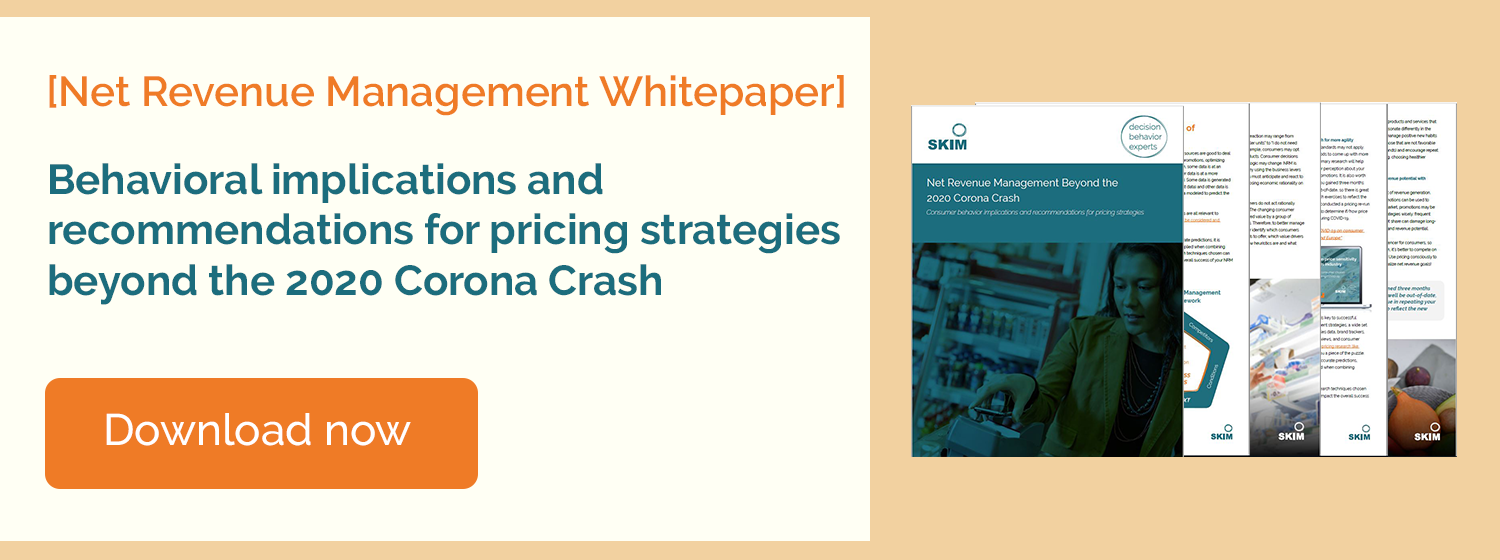FMCG revenue professionals are challenged with creating a win-win-win situation: Provide consumers with the right product at the right price, create value with retail customers in challenging times, all while delivering top and bottom line growth. And all of this while working within legal limits in countries that prohibit resale price maintenance.
Leading consumer goods companies are increasingly adopting a net revenue management (NRM) approach to tackle this challenge. By applying a structured approach to analytics and encouraging open-mindedness, companies like Unilever are maximizing their net revenue and profits.
While you may subscribe to this holistic approach in theory, how exactly does an NRM mindset work at the brand level? How can NRM help you adapt to sudden market changes, like rising costs, or when you need to stake your claim in a fiercely competitive category?
As an early expert in net revenue management, Chi Wai Tang, NRM Country Lead for Unilever, shares his first-hand experience of embracing this approach for two leading Dutch brands: Unox and Andrélon. Read on to learn about Unilever’s NRM journey and how to adopt an NRM mindset for your brands.
Ushering in an NRM mindset to unlock growth potential

Chi Wai Tang joined Unilever in 2016 as senior deployment manager for revenue management in Europe. He describes NRM as “a disciplined journey of setting clear goals and diagnosing the root cause of problems to bring about new thinking. It involves taking multiple viewpoints to a revenue management problem by asking different questions. Unilever applies advanced methods to synthesize and visualize insights from available data (from internal and external sources) to build an understanding and devise plans and reviews for the future.”
Chi Wai currently works closely with Unilever’s Dutch brand teams as the Netherlands NRM lead based in the company’s local headquarters. With raw material costs increasing and Unilever experiencing stagnant market growth, Chi Wai focuses on price and share growth through NRM.
“NRM has created more transparency in trade investments and our ‘five-lever analytics’ have identified pricing opportunities,” he said. These levers include: portfolio, pack price, mix and distribution, promotional strategy, and trade terms (i.e. contracts).”
To effectively apply these levers, you need rigorous data analytics and that’s where our team is often called. At SKIM, we developed an NRM Framework to further break down the product, portfolio and price decisions based on the five-lever approach. By distinguishing between internal levers (e.g. brand, pack, price) and the external ones (e.g. channel, trade term conditions, etc.), we ensure our projects are tailored to help our clients make more holistic pricing decisions.

Analytics approach for successful NRM strategies
In today’s big data world, a successful NRM strategy is a data-driven one. Revenue management professionals, such as Chi Wai, are increasingly leveraging a wider set of data sources, including everything from segmentation data and brand trackers to historical sales data and consumer insights on price elasticity.
If you’re recommending a price change to customers or considering an adjustment to your portfolio, you know it’s vital to understand and predict the impact on consumer behavior. However, the accuracy of the revenue/share prediction is often determined by which research method is used and the analytical rigor behind the consumer insights.
While historical sales data can be used to extrapolate insights, past sales alone won’t predict future consumer decision behavior. Chi Wai points out what many of you face every day: the world will never move slower than today – consumer lifestyles and environments are continuously changing. Robust analytics which can predict consumer choices are needed in order to formulate the smartest retailer pricing recommendations today.
 We offer discrete choice modeling, or conjoint analysis, to do just that. With 40 years of choice modeling expertise, we know this research method is a powerful and accurate way of testing your proposed pricing strategies.
We offer discrete choice modeling, or conjoint analysis, to do just that. With 40 years of choice modeling expertise, we know this research method is a powerful and accurate way of testing your proposed pricing strategies.
With over a decade of revenue management experience, Chi Wai describes the conjoint method as “the best of the best.”
He adds, “from an NRM perspective, your research needs to simulate realistic shopping trips – from the shopper type and channel, to promotions and competition – and calibrate with market and financial data into a robust prediction model. That’s what SKIM does best.
When I was at Imperial Tobacco (2015), we led a global tender where SKIM came out as best in accuracy versus costs.”
NRM in action: two Unilever brands, two challenges
How does Chi Wai put his NRM vision to work at Unilever?
Two of his recent projects best illustrate how FMCG brands bring an NRM approach to reality. Chi Wai needed to investigate pricing strategies for two Dutch brands, both facing important questions about how best to adapt:
- Unox covers various food products, including smoked sausage (rookworst), soups and noodles. With an 80-year history, it’s the most valuable brand for Unilever in the Netherlands. With the rising cost of pork due to the Asian swine flu, Unilever leveraged NRM’s structured analysis approach to bring various solutions forward that was tested with the conjoint model.
- Andrélon is the most sold hair care brand in the Netherlands, with an extensive range of shampoos, conditioners and styling products. Unilever’s goal is to keep growing share, when it was already the category leader – a category with nearly 93% retail promotions at any given time.
 Considering the “five-lever analytics” approach to NRM, Chi Wai provided us with market and customer segmentation data, promotional information and channel preferences, for both brands. Armed with these various data sources, our team of conjoint experts designed two virtual shelf studies, powered by discrete choice modeling, to determine the impact of potential price and size changes and the optimal portfolio for Unilever.
Considering the “five-lever analytics” approach to NRM, Chi Wai provided us with market and customer segmentation data, promotional information and channel preferences, for both brands. Armed with these various data sources, our team of conjoint experts designed two virtual shelf studies, powered by discrete choice modeling, to determine the impact of potential price and size changes and the optimal portfolio for Unilever.
In these studies, consumers are presented with various brands, retailer prices and pack sizes on a digital retail shelf, replicating the consumer’s in-store situation. The conjoint exercise measures the trade-offs Unilever’s different shopper types made as different options were presented. For Unox alone, we looked at 10 different shopper types.
The goal of both studies was to obtain robust pricing and portfolio insights for both the Unox and Andrélon brand teams, as well as their retail customers. “We needed to make a convincing case to retailers under pressure in a tough climate,” said Chi Wai.
The results?
At the end of each study, Chi Wai received the SKIM simulator tool, which predicted shopper behaviors across segments and scenarios and assessed the volume and revenue impact of the price or pack size changes.
For Unox, Chi Wai revealed he “trusted SKIM’s approach as the most accurate available today.” For Andrélon, the level of promo pressure was a key question.

“It’s a challenge to incorporate promotion into a virtual shelf model, but SKIM had a strong approach,” Chi Wai adds. For Andrélon, we built a robust pricing model based on propriety SKIM algorithms that also predicted the effect of promotions on consumer behavior.
According to Chi Wai, the results helped Unilever’s trade teams present “a strong value-add that showcased them as category captains in this field.”
NRM and SKIM allowed Unilever to step-up retailer conversations with in-depth and factual insights, such as price elasticity, to focus on the consumer’s wallet. The customer feedback was very positive.
Expert advice: How to get started with NRM
At Unilever, Chi Wai strives to create an environment of “radical open-mindedness and transparency, which is invaluable for rapid learning and effective change.” When asked how other revenue and pricing professionals can start to adopt an NRM mindset, Chi Wai said:
- Be courageous and commit to adopting revenue management.
It’s OK to start with small steps! Consider adding one additional data set when you set out to make your next pricing decision. - There might be some initial discomfort as you ask difficult questions, but after that comes growth.
Don’t shy away from the rigorous process: “In for a penny, in for a pound” is what brings results. - Consider how you communicate your findings.
Many revenue professionals are good with numbers, but don’t forget the role of emotion. Keep the message simple, and evidence-base for credibility.
 if you’d like to know how SKIM can help you build your pricing strategy and get started on your NRM journey.
if you’d like to know how SKIM can help you build your pricing strategy and get started on your NRM journey.


